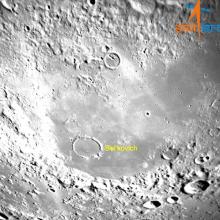Listen to today's episode of StarDate on the web the same day it airs in high-quality streaming audio without any extra ads or announcements. Choose a $8 one-month pass, or listen every day for a year for just $30.
You are here
Moon and Spica
A cobra slithers across the surface of the Moon. It’s a hundred miles long and up to six miles wide — big enough to see through a small telescope. And it’s almost four billion years old.
The cobra is called Schroter’s Valley, and it’s the biggest valley on the Moon. It begins at a deep hole called the Cobra Head, then twists across a plateau that was thrust upward when a city-sized boulder struck the Moon long ago.
The entire plateau shows signs of ancient volcanic activity. It’s covered by a reddish material that contains lots of tiny glass beads. The beads formed when volcanoes blasted molten rock high above the lunar surface. And narrow, twisting channels carved by flowing lava criss-cross the plateau.
Schroter’s Valley is the largest channel, but it probably formed in a different way from the others. It may represent a fault line that formed when the plateau was created. Giant blocks along this line dropped, leaving a long, wide valley. Lava once spilled from the Cobra Head, then flowed through that valley toward a volcanic plain — the Ocean of Storms.
There are no big volcanoes on the Moon today. But there’s evidence of some activity in the region around Schroter’s Valley — swirls of gas that may escape from below the lunar crust.
And look for the Moon late tonight. It climbs into good view by around 1 o’clock, with a bright companion to the lower right of the Moon: Spica, the brightest star of the constellation Virgo.
Script by Damond Benningfield






